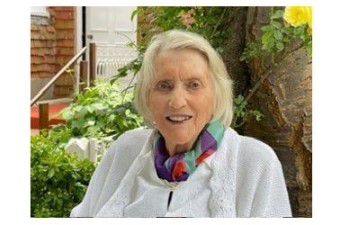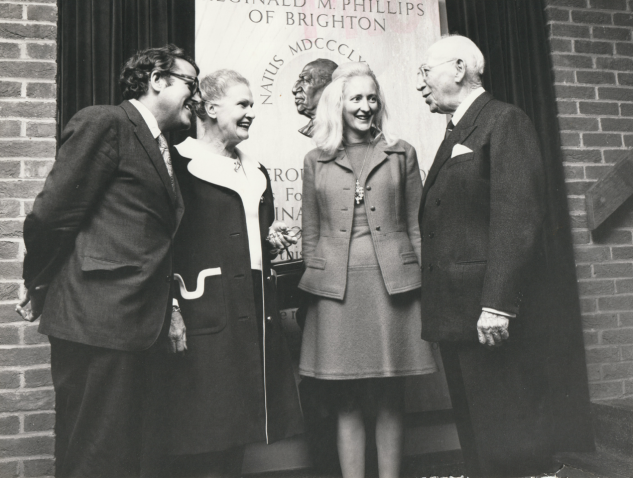Obituary: Lady Susan Briggs
Posted on behalf of: Communications
Last updated: Monday, 11 August 2025

Lady Susan Briggs
Lady Susan Briggs, devoted wife of the late former University of Sussex Vice-Chancellor Lord Asa Briggs, and a remarkable figure in British academic and social life, died on 3 June 2025, aged 92. As the partner of one of Britain’s most distinguished historians, Lady Briggs played an integral role in a chapter of British academic history that helped shape modern higher education.
Born Susan Anne Banwell on 27 December 1932 to a farming family in west Wiltshire, she came from humble but determined roots. Her father’s parents were working freehold farmers near Banwell village in Somerset. Her father had left school at just 12 as the First World War began, while her mother, also from a farming family, left at 14. Despite these modest beginnings, Susan showed exceptional intellectual promise from an early age, learning to read at around four years old and displaying a natural love of learning that would define her life.
In 1943, at the age of 10, Susan won a scholarship, the only pupil in her school to achieve this distinction. Though offered a place at Trowbridge High School (like the path taken by her future husband Asa Briggs at Keighley Grammar School), her mother chose instead to send her to a nearby Roman Catholic convent school as a weekly boarder. There, she flourished academically, particularly in history under the guidance of her favourite teacher, Mother Gregory, who had studied at Newnham College, Cambridge. In one of life’s remarkable coincidences, Mother Gregory and Asa Briggs had attended the same lectures at Cambridge, although they didn’t know each other at the time.
Susan’s academic excellence earned her a place at St Anne’s College, Oxford, where she read Politics, Philosophy, and Economics (PPE) from 1951 to 1954. At Oxford, she had what she later described as a “fabulous time,” forming lasting friendships including with Michael Heseltine, who was to become a Conservative politician. While her contemporaries often gravitated toward politics, Susan was particularly drawn to the economics aspect of her degree. She was an active member of the Balliol-St Anne’s choir, where her love of choral music enriched her university experience.
It was through academia that Susan met her future husband. After graduating in 1954, she received a grant from the county of Wiltshire (notably, the first time the county had ever provided funding for a higher degree) though she ultimately did not finish the advanced study. But, at the time needing additional funding, her tutor at St Anne’s recommended she speak with Asa Briggs, then a Reader who was completing his final year at Worcester College before departing for a professorship at Leeds. Their meeting would change both their lives.
On 1 September 1955, Susan and Asa married in Oxford, immediately embarking on their new life together in Leeds where Asa had accepted the Chair of Modern History. Their partnership would prove to be both personally fulfilling and professionally transformative, as Susan became an essential part of Asa’s remarkable academic journey.
A pivotal moment in their lives came in April 1960 at the Workers’ Educational Association annual conference in Brighton. While Asa attended the conference, Susan took a memorable walk through Stanmer Park, part of which, little did she know it at the time, would later become the University of Sussex campus. The next day, they lunched with John Fulton, the newly-appointed Principal of the University College of Sussex, and his wife Jacqueline. As the Briggs departed Brighton, Fulton made a spontaneous offer that would shape their future: shouting through the train window as it pulled away, “Would you like to come and join us at Sussex?” Asa called back, “I’ll let you know before we go to Australia!”
True to his word, just before their departure for Australia in June, Asa remembered his promise. In a moment that was characteristic of Asa, he dashed off the ship at the port just before it left to telephone Fulton, leaving Susan alone with their two small children and worried he might miss the sailing. Asa accepted the position, initially as Dean of European Studies, and luckily caught the boat, but on mulling on the offer he sent a telegram from the next port reading “Make it Social Studies!” Asa and Susan’s excitement about joining a new university was infectious, and during their time in Australia, Asa delivered his influential lecture The Map of Learning to the Research Students Association in Canberra on 2 November 1960, ideas that would feed directly into Sussex’s founding philosophy.

Lord Asa Briggs (left), Lady Susan Briggs (second right) with Reginald Phillips (right) a generous benefactor to the University, and a woman whose identity is currently not known.
Asa worked at Sussex between 1961 and 1976, and Susan’s contribution to Sussex extended far beyond her role as his wife. She became a vital part of the University’s social fabric, connecting Sussex to wider social networks and enhancing its impact both locally and nationally. Her natural warmth and intelligence made her a bridge between the academic community and the broader world. Crucially, as Susan herself noted with characteristic humour, she could drive, an essential skill given Asa’s inability behind the wheel. “Asa was a famous non-driver,” she later remarked, “but it would have been a nightmare if he had driven – he had no road sense!” This practical contribution enabled them to maintain the frenetic schedule of social and academic engagements that were so important to Sussex’s early development.
During Asa’s tenure as Vice-Chancellor of Sussex from 1967 to 1976, Susan’s support was instrumental in establishing the University’s reputation and culture. Her understanding of both the academic world and broader society helped Sussex navigate its formative years and establish the connections that would serve it for decades to come.
Beyond her role at Sussex, Susan was an author in her own right. She studied and had an abiding interest in history, writing Keep Smiling Through: Home Front, 1939-45 and, working alongside her husband, she co-edited Cap And Bell, a history of the first 20 years of Punch Magazine, demonstrating the shared intellectual partnership that extended throughout their marriage.
Susan holds a special place in the history of the University of Sussex and in the hearts of many in the community, particularly staff and alumni who were at Sussex during the transformative 1960s and 1970s. Her legacy lives on in the institution she helped to shape and the countless lives she touched through more than six decades of connection with the University.
Susan was predeceased by her husband who died in 2016. She is survived by her two sons, Daniel and Matthew, and two daughters, Katharine and Judith, as well as many grandchildren.
Lady Susan Briggs embodied the best of her generation: intellectual curiosity, social grace, practical wisdom, and unwavering support for the causes and people she believed in. Her life spanned from the farming communities of west Wiltshire to the corridors of academia, always maintaining the warmth, humour, and groundedness that made her beloved by all who knew her.
Professor David M. Berry
Faculty of Media, Arts and Humanities
